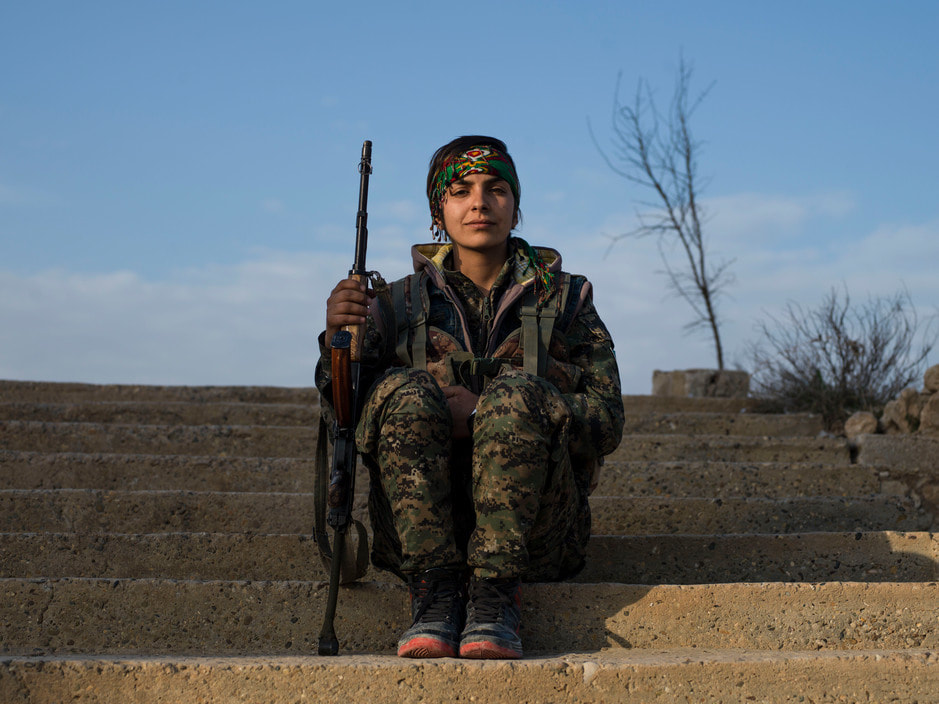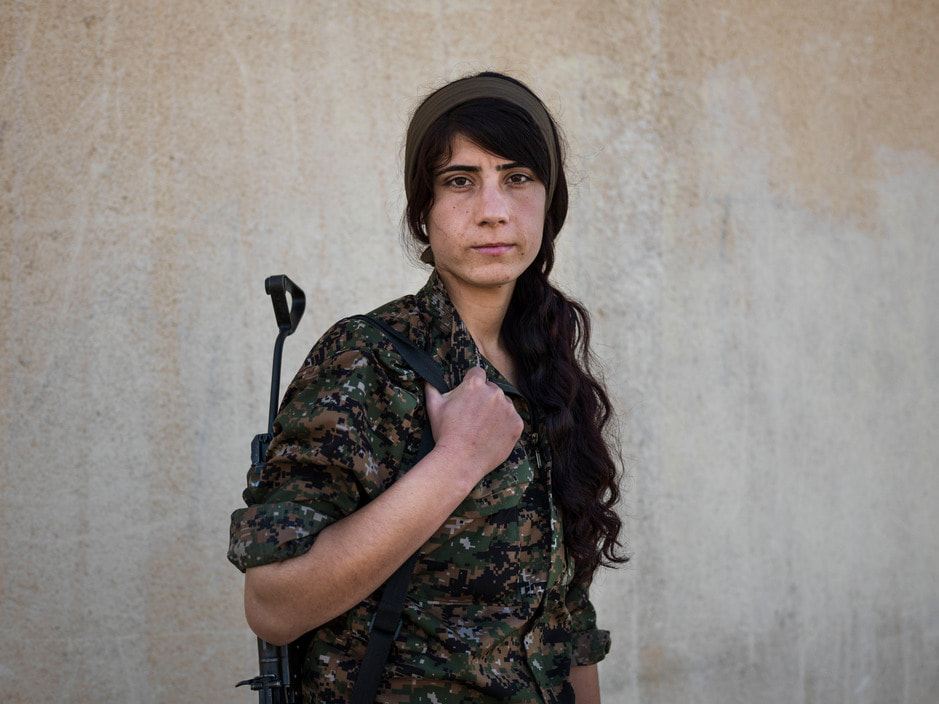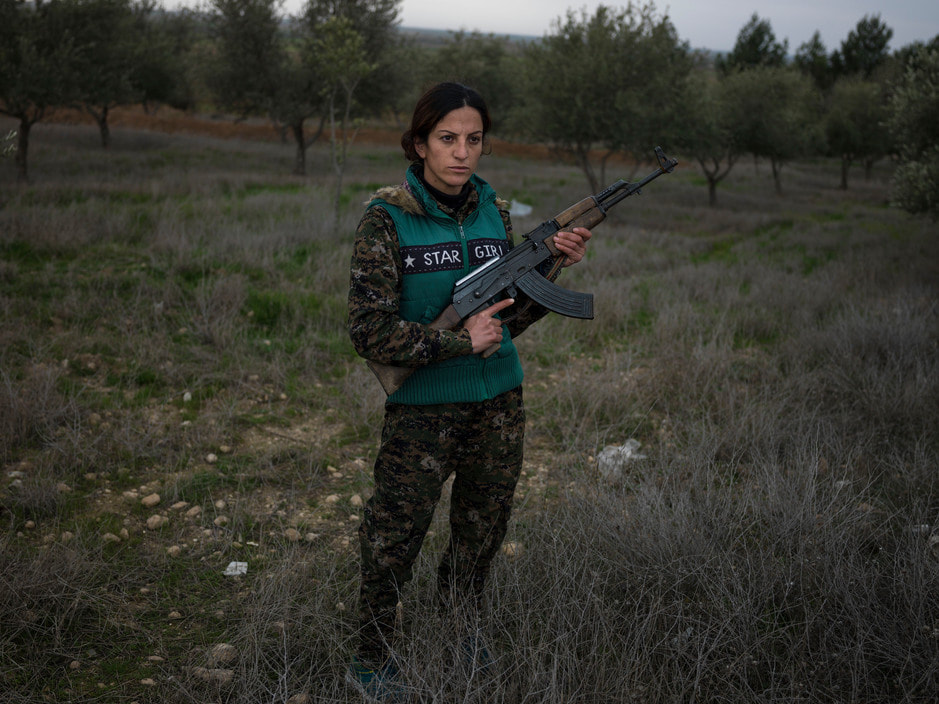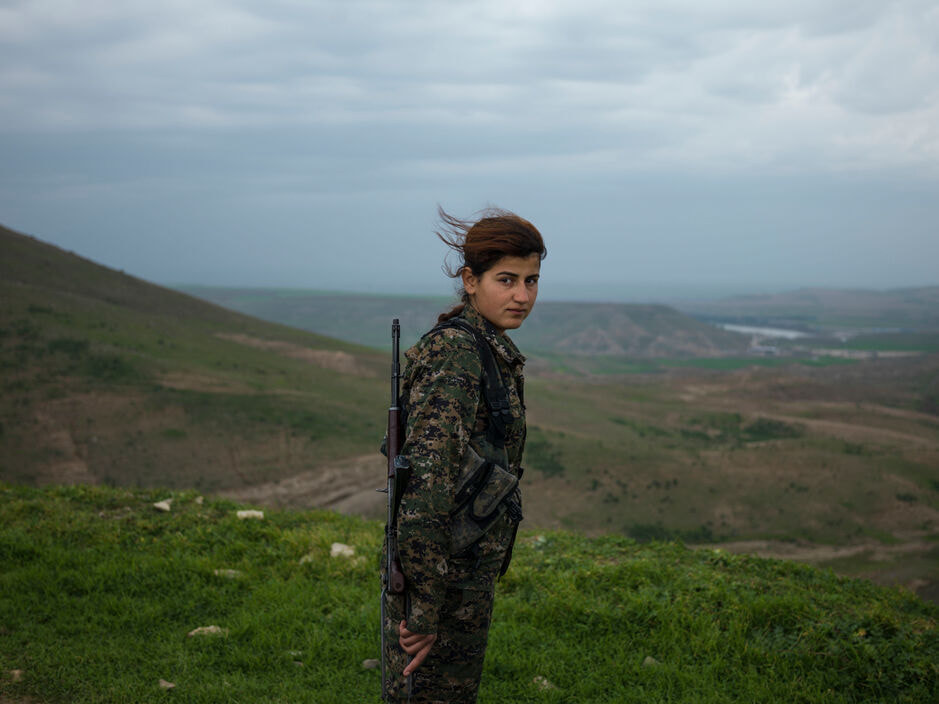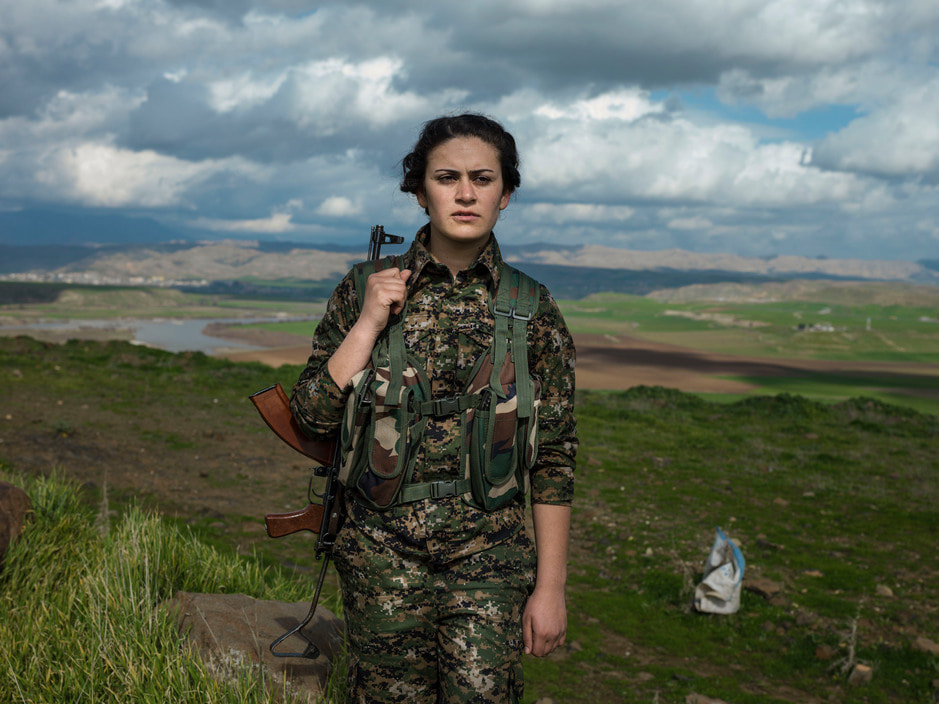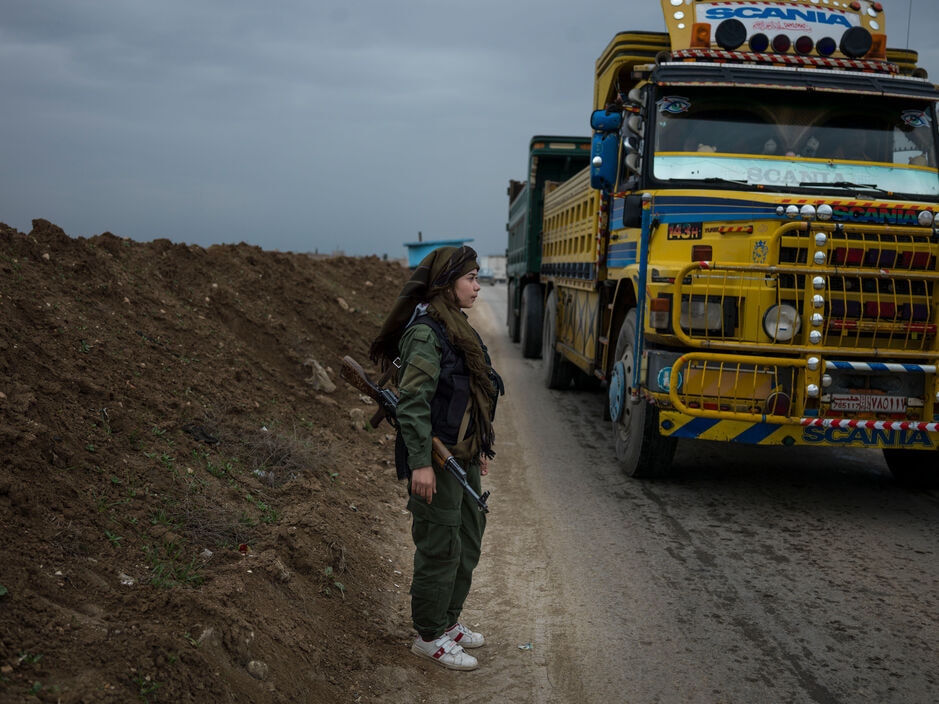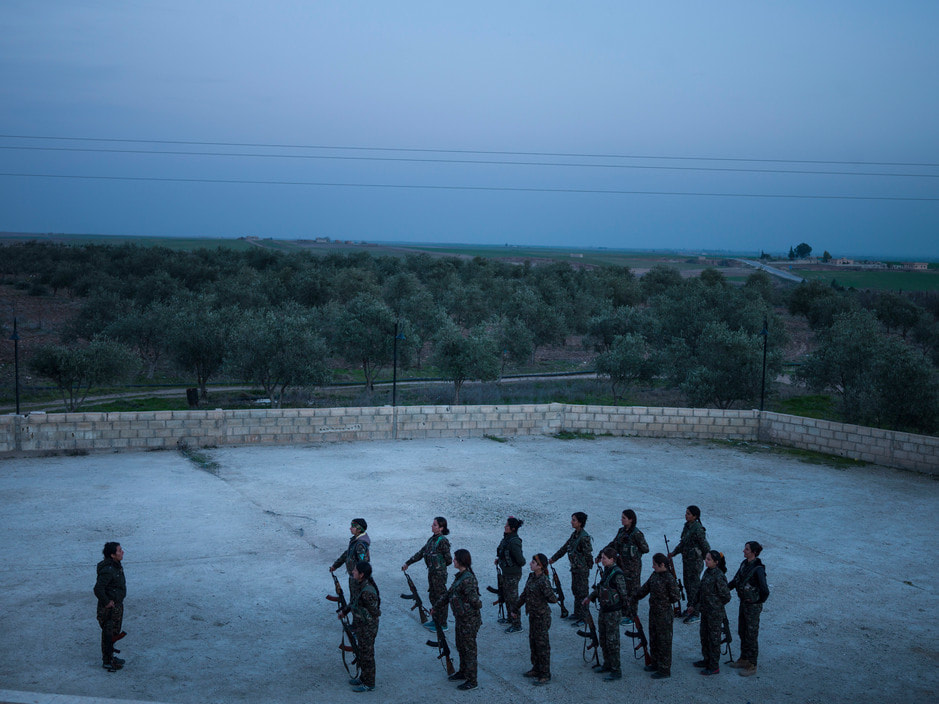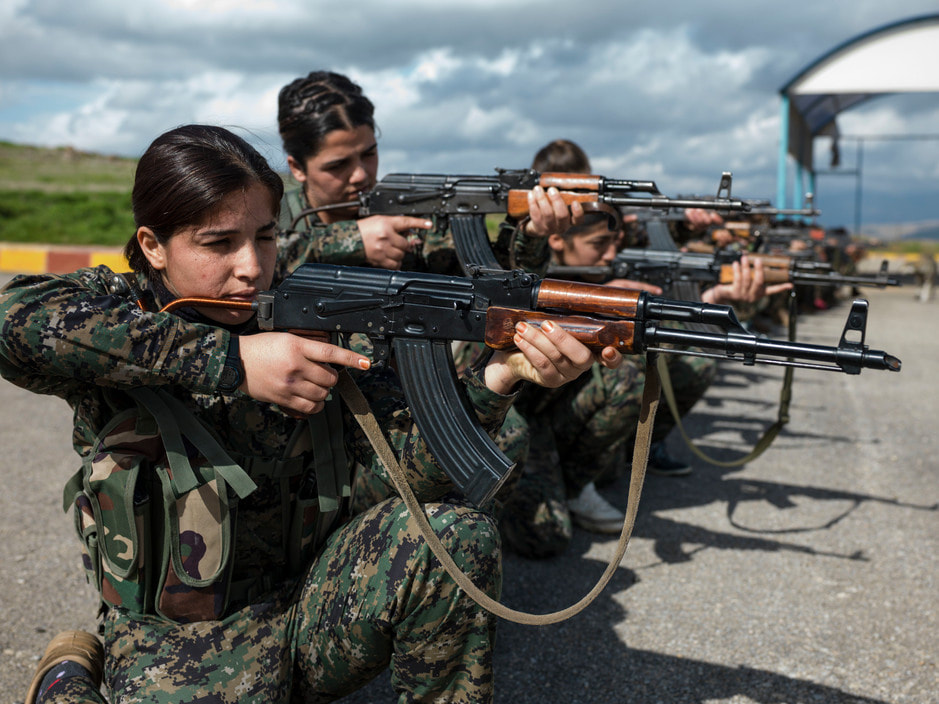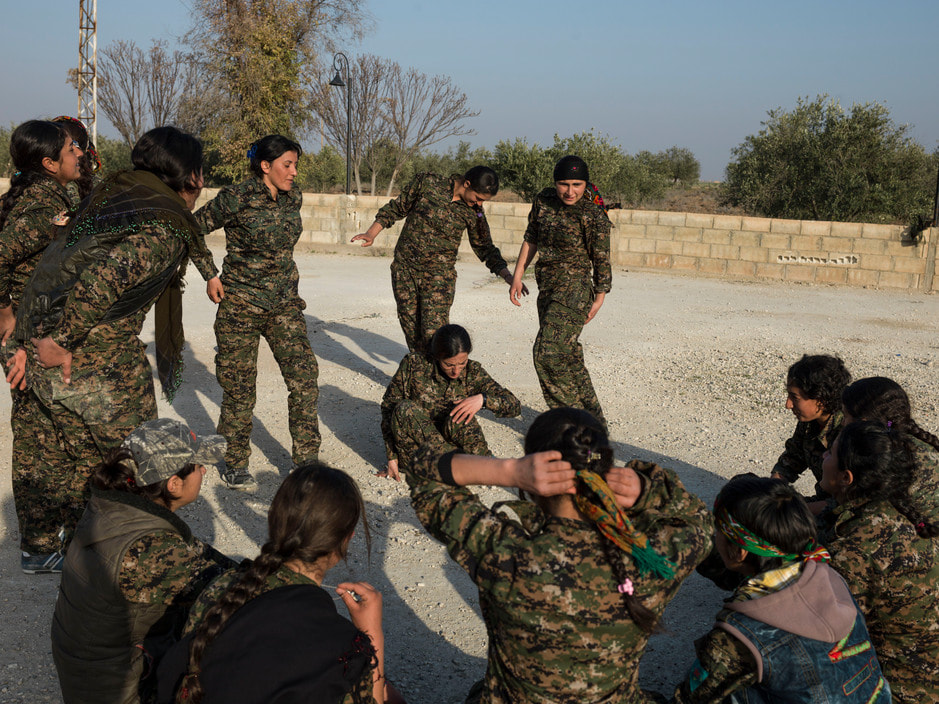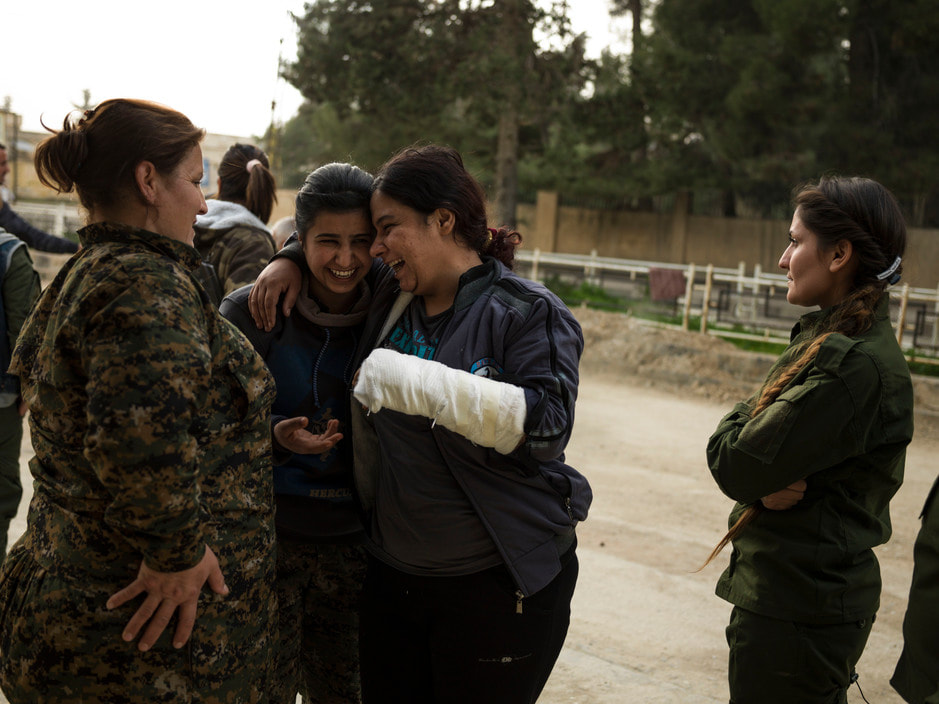|
|
About the PhotographerMagnum photographer Newsha Tavakolian is known for her powerful work covering wars in Iraq and social issues in her native Iran. A self-taught photographer, Tavakolian began working professionally in the Iranian press at the age of 16, at women’s daily newspaper Zan. At the age of 18, she was the youngest photographer to cover the 1999 student uprising. In 2003, she started working internationally, covering the war in Iraq. She has since covered regional conflicts, natural disasters, and made social documentary stories. Her work has been published in international magazines and newspapers such as Time Magazine, Newsweek, Stern, Le Figaro, Colors, The New York Times, Der Spiegel, Le Monde, NRC Handelsblad, and National Geographic. In 2015, Tavakolian produced this series of images of female Kurdish soldiers taking the battle to the Islamic State of Iraq and Greater Syria. |
|
The following interview was conducted via Zoom on January 8, 2022. Tavakolian was speaking in English, which is not her native language.
TiP: Newsha, could you talk a little bit about how you started this work photographing women guerrilla fighters?
Tavakolian: In 2015, I got a phone call from Alice Gabriner, one of the editors that was working at that time at Time magazine. Because she knew my work, she knew that I speak Kurdish, because my mom, she's a Kurd from Iran. And she said, “Oh, are you interested to go to Syria to photograph the YPJ [Women's Protection Units] women that are now fighting against ISIS?” And immediately I said yes, and I think within a couple of days I was at the border of Iraq and Syria to enter northern Syria, where they are based.
TiP: What was your first impression when you started meeting these very young women?
Tavakolian: It was really interesting, and it made me think a lot about truth, actually, in photography, because I was supposed to go there and show how brave and amazing these women are. Americans were very excited about these Kurdish women who are fighting against ISIS, and they wanted me to make them look like heroes. It was like the whole world were pressing these women, and I have to say they are extremely brave and courageous. I admire them for that. But to be honest, the truth was not that simple. It was much more complex than what I thought. So when I arrived at the border of Syria, I had to wait for a couple of days because they would not let me into Syria. So I was in Iraq. And after two days, I got in and I didn't know anybody. I had no connection. It was just me and a translator that could speak English and Kurdish. And so I started just driving around and looking. It was really a gloomy city. It was very dark. You could see how people there are living under pressure and also they are scared. So many young people, they were just walking around the dark city. Sometimes the only light you could see when it was getting darker was the lights of the cars and some houses that had some lights on. So for two days, I couldn't find anybody. And because also they were very conscious… I would say, “I'm a photographer, I came for Time magazine.” But immediately, when they would know that I'm Iranian, they would say, “Oh no, it is not possible.” And then at the end, after the two days in one checkpoint, there was a woman, I think she was one of the generals. By chance, she was there. I went to her and started speaking Kurdish and I told her my story and she was like, “Okay, let's go to my base.” I went to her base, and she introduced me to other women fighters that were just coming back to rest for a couple of days in that base, before they go to the front line to fight. And I started photographing them and interviewing them. For me, their words were absolutely as important as the images, because I wanted to hear their stories first person. This is how it started. And then another woman introduced me to another base and another base introduced me to another base. So, I was going around. At the end, after five days that I was there shooting, they found out about me, the head of the communication of the soldiers. It was a man, and he said, “Immediately, you should leave this area.” And then I had to leave.
Tavakolian: In 2015, I got a phone call from Alice Gabriner, one of the editors that was working at that time at Time magazine. Because she knew my work, she knew that I speak Kurdish, because my mom, she's a Kurd from Iran. And she said, “Oh, are you interested to go to Syria to photograph the YPJ [Women's Protection Units] women that are now fighting against ISIS?” And immediately I said yes, and I think within a couple of days I was at the border of Iraq and Syria to enter northern Syria, where they are based.
TiP: What was your first impression when you started meeting these very young women?
Tavakolian: It was really interesting, and it made me think a lot about truth, actually, in photography, because I was supposed to go there and show how brave and amazing these women are. Americans were very excited about these Kurdish women who are fighting against ISIS, and they wanted me to make them look like heroes. It was like the whole world were pressing these women, and I have to say they are extremely brave and courageous. I admire them for that. But to be honest, the truth was not that simple. It was much more complex than what I thought. So when I arrived at the border of Syria, I had to wait for a couple of days because they would not let me into Syria. So I was in Iraq. And after two days, I got in and I didn't know anybody. I had no connection. It was just me and a translator that could speak English and Kurdish. And so I started just driving around and looking. It was really a gloomy city. It was very dark. You could see how people there are living under pressure and also they are scared. So many young people, they were just walking around the dark city. Sometimes the only light you could see when it was getting darker was the lights of the cars and some houses that had some lights on. So for two days, I couldn't find anybody. And because also they were very conscious… I would say, “I'm a photographer, I came for Time magazine.” But immediately, when they would know that I'm Iranian, they would say, “Oh no, it is not possible.” And then at the end, after the two days in one checkpoint, there was a woman, I think she was one of the generals. By chance, she was there. I went to her and started speaking Kurdish and I told her my story and she was like, “Okay, let's go to my base.” I went to her base, and she introduced me to other women fighters that were just coming back to rest for a couple of days in that base, before they go to the front line to fight. And I started photographing them and interviewing them. For me, their words were absolutely as important as the images, because I wanted to hear their stories first person. This is how it started. And then another woman introduced me to another base and another base introduced me to another base. So, I was going around. At the end, after five days that I was there shooting, they found out about me, the head of the communication of the soldiers. It was a man, and he said, “Immediately, you should leave this area.” And then I had to leave.
|
“After the revolution, they brought a female martyr from Qandil. When I saw that, I was quite impressed and decided to join YPJ. In our community of Kurdish people, I want to find my freedom and know myself. YPJ allowed me to do that. Since I joined YPJ, I have had the feeling that I am equal to men and I am no less than what they are. I fought with ISIS in Serikani. I killed one of their fighters. At first it was difficult, but then I got used to the idea and it became normal for me. When I killed the man, I started cheering loudly so his fellow fighters would hear me and know that a woman had killed their friend. We were a group of five YPJ and five YPG members when we killed 30 ISIS fighters. We told the men that we wanted to bury them. But we did not decapitate the bodies. Fighting in this war empowered me to get my rights myself and do not wait for them to be given to me. I feel like a free woman now.”
~Zilan Orkesh, 18 |
|
“When the revolution happened in Rojava, I knew that I wanted to have a role in it. The majority of the members of our society are women, but the only roles they are allowed to play are those of home-makers and mothers. But in this revolution, the YPJ women make up a whole army. And this is an opportunity for us women to show that we can play a different role. Usually men say that we cannot fight to defend ourselves and others, but with this revolution we are proving them wrong. My comrades and I attacked ISIS checkpoints in Talala. They were fighting back using all the heavy artillary they had. But we won the fight and seized the checkpoint and took the village under our own control. Now I feel that I can do anything I want. But before this, I thought that only my father and brother could protect me. But now as a YPJ woman, not only I can defend myself, but also I can protect others.”
~Suzdar, 21 |
|
“It's been one year and four months since I joined YPJ. When I saw Martyr Deli on TV after ISIS beheaded her, I went to her burial ceremony the next day in Amuda. I saw Deli's mother sobbing madly. Right there I swore to myself to avenge her death. I joined YPJ the day after. In the past, women had various roles in the society. but all those roles were taken from them. We are here now to take back the role of women in society. I grew up in a country, where I was not allowed to speak my mother tongue of Kurdish. I was not allowed to have a Kurdish name. If you were a pro-Kurdish activist, they'd arrest you and put you in jail. But since the Rojava revolution, we have been getting back our rights. We were not allowed to speak our language before, and now ISIS wants to wipe us off completely from the Earth. I fought with ISIS in Serikani. I captured one of them and wanted to kill him, but my comrades did not let me do so. He kept staring at the ground and would not look at me, because he said it was forbidden by his religion to look at a woman. I have changed a lot. My way of thinking about the world has changed since I joined YPJ. Maybe some people wonder why we're doing this. But when they get to know us better, they will understand why. We are emotional people.”
~Saria Zilan, 18 |
|
“I joined YPJ about seven months ago, because I was looking for something meaningful in my life and my leader [Ocalan] showed me the way and my role in the society. We live in a world where women are dominated by men. We are here to take control of our own future. We are not merely fighting with arms; we fight with our thoughts. Ocalan's ideology is always in our hearts and minds and it is with his thought that we become so empowered that we can even become better soldiers than men. When I am at the frontline, the thought of all the cruelty and injustice against women enrages me so much that I become extra-powerful in combat. I injured an ISIS jihadi in Kobane. When he was wounded, all his friends left him behind and ran away. Later I went there and buried his body. I now feel that I am very powerful and can defend my home, my friends, my country, and myself. Many of us have been matryred and I see no path other than the continuation of their path.”
~Torin Khairegi, 18 |
|
“In order to defend the women of the world and my country, I joined YPJ three years ago. I believe that the role of female fighters is much more important than the role of male fightes, because they are already free, but we are fighting for the freedom of all the women in the world. I fought with ISIS in Tel-Marouf village. We fought back for a while until we got back the village, but the surrounding villages are still occupied by their forces. I was fighting with ISIS members door to door, shooting them in people's homes. First I was shooting at them with a Doshka. But then we were attacked and some of my comrades were injured. So I started using a Kalashnikov rifle. I have lost my friends, like Arin and Bahar, but I promise them that I will continue their path. ISIS and many other anti-women groups want to wipe women off the Earth. But YPJ won't allow that.”
~Farashin Mehriva, 21 |
TiP: Fine art photographers tend to dismiss the idea of there being any truth in photography, but when you're immersed in a world like that, which is so much on the edge of crisis, where people are living on edge of life and death, truth takes on a different significance. So, could you talk a little bit about that?
Tavakolian: To be honest, for me, there is no truth in photography. It's just a perspective. It’s just one angle out of millions of angles that you can show. And I never thought, in my work, I'm going to show the truth. Because the truth for them is different than the truth for me. For example, if we talk about the work that I did in Syria, their truth is totally different than what I saw. I saw all these women, most of them, they were abused. They live in injustice. They were beaten by their family members. They had no opportunity to grow as a woman. They were oppressed. Then this group that have their ideology and need soldiers, they go after these girls, that most of them are really young, and they brainwash them to bring them to the group, to make them a soldier and to fight because they need people. And then they give them comfort. They give them self-confidence. They give them love. But these are all based on the ideology that they believe in. This is how I saw it, and I don't want to make them small or anything, not at all, they're absolutely brave women. But the circumstances make them do this. If they were living in a normal situation, 99% of these women, they would not become fighters. Who wants to go and fight? Who wants to be in a war zone? For them, it's another thing. They believe in something else. Every day, before they go anywhere, they have to read books of their leader, Öcalan, who is in prison in Turkey. They have to read his manifest.
TiP: Are they Islamic women? Are they still practicing the faith?
Tavakolian: They're Muslim, but they are not Islamic. They don't practice Islam. Because they have ideology, right? Ideology has replaced religion for them. So, they will keep on fighting until they get what they demand. have their land, like Kurdistan, that they believe that they should have a country. Kurdish people are divided into four main communities that live in under pressure in Iran, Iraq, Turkey, and Syria. In these countries, they cannot study in their own language. They can be minoritized and isolated as a result.
TiP: It's a terrible situation there.
Tavakolian: It is a very complicated situation, and I was there for less than a week. How can I talk about truth? What is the truth? So, I decided from the first day that I arrived, I said, “I'm just going to let this story take me and I will see what I would do.” I will let them talk to me and tell me their stories. And when you read these stories, the captions under each image, you see that really many of them, they suffered. They suffered, not only because of the war, because of family members, the situation that they’re born into.
Tavakolian: To be honest, for me, there is no truth in photography. It's just a perspective. It’s just one angle out of millions of angles that you can show. And I never thought, in my work, I'm going to show the truth. Because the truth for them is different than the truth for me. For example, if we talk about the work that I did in Syria, their truth is totally different than what I saw. I saw all these women, most of them, they were abused. They live in injustice. They were beaten by their family members. They had no opportunity to grow as a woman. They were oppressed. Then this group that have their ideology and need soldiers, they go after these girls, that most of them are really young, and they brainwash them to bring them to the group, to make them a soldier and to fight because they need people. And then they give them comfort. They give them self-confidence. They give them love. But these are all based on the ideology that they believe in. This is how I saw it, and I don't want to make them small or anything, not at all, they're absolutely brave women. But the circumstances make them do this. If they were living in a normal situation, 99% of these women, they would not become fighters. Who wants to go and fight? Who wants to be in a war zone? For them, it's another thing. They believe in something else. Every day, before they go anywhere, they have to read books of their leader, Öcalan, who is in prison in Turkey. They have to read his manifest.
TiP: Are they Islamic women? Are they still practicing the faith?
Tavakolian: They're Muslim, but they are not Islamic. They don't practice Islam. Because they have ideology, right? Ideology has replaced religion for them. So, they will keep on fighting until they get what they demand. have their land, like Kurdistan, that they believe that they should have a country. Kurdish people are divided into four main communities that live in under pressure in Iran, Iraq, Turkey, and Syria. In these countries, they cannot study in their own language. They can be minoritized and isolated as a result.
TiP: It's a terrible situation there.
Tavakolian: It is a very complicated situation, and I was there for less than a week. How can I talk about truth? What is the truth? So, I decided from the first day that I arrived, I said, “I'm just going to let this story take me and I will see what I would do.” I will let them talk to me and tell me their stories. And when you read these stories, the captions under each image, you see that really many of them, they suffered. They suffered, not only because of the war, because of family members, the situation that they’re born into.
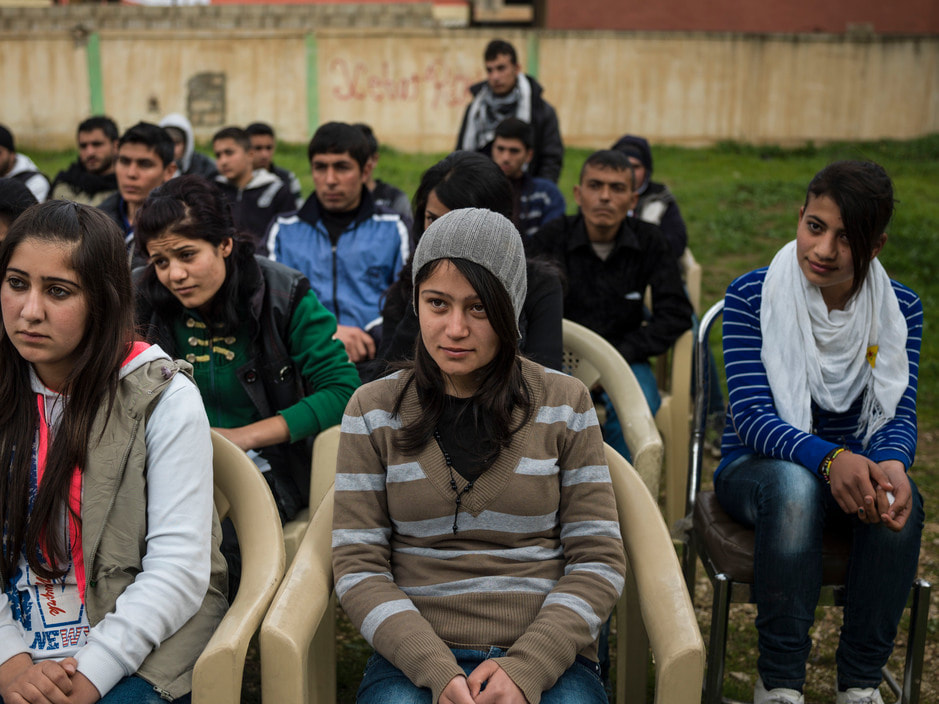
Everyday PYD (the Democratic Union Party of Syria), an affiliate of PKK (Kirdistan Workers' Party), gathers young people from Rojava area and teaches them its ideology. Many of these teenagers will soon be drafted into YPJ and YPG armies. Institute for Young Revolutionaries in Terbespe, Rojava, Syria, 2015. © Newsha Tavakolian / Magnum Photos
TiP: It's interesting to me looking at the differences between the photographs that are portraits and those that are more documentary in nature. The portraits feel posed, they're posing for you. Talk about that process of making these kinds of portraits. Are they deciding how they want to be presented to you?
Tavakolian: It is not a collaboration for me. This project was not a collaboration, I was there to document their situation and to listen to them, to hear their story. But everywhere I went, I didn't have actually a lot of time, because I knew at some point they’re going to kick me out. So, I would just use the very limited space that I was in to take their portraits. But I wanted to be very close to the reality.
TiP: So, in terms of the photographs that you made, which do you feel are closest to the reality? Do you distinguish between the ones that are more documentary and the ones that are portraits, or are they the same?
Tavakolian: Really, this is the style that I shoot. Everywhere I go, I'm really interested in the landscape and the surroundings of the place that I'm going to shoot and also the portraits, and really, I don't make a difference between these two. For me, it’s just the way I shoot.
Tavakolian: It is not a collaboration for me. This project was not a collaboration, I was there to document their situation and to listen to them, to hear their story. But everywhere I went, I didn't have actually a lot of time, because I knew at some point they’re going to kick me out. So, I would just use the very limited space that I was in to take their portraits. But I wanted to be very close to the reality.
TiP: So, in terms of the photographs that you made, which do you feel are closest to the reality? Do you distinguish between the ones that are more documentary and the ones that are portraits, or are they the same?
Tavakolian: Really, this is the style that I shoot. Everywhere I go, I'm really interested in the landscape and the surroundings of the place that I'm going to shoot and also the portraits, and really, I don't make a difference between these two. For me, it’s just the way I shoot.
TiP: So, they’re sent into combat. They're given limited training to use Kalashnikov rifles and automatic weapons. And then they go out into the…
Tavakolian: …and you know, they cannot marry. They cannot have sex.
TiP: Oh, really?
Tavakolian: Oh yes, because it's a closed group that cultivates some form of cult mentality. There are so many rules, and because they believe they have to be married to the ideology, they cannot have relationships. They cannot have kids. Many of them who already were married, they leave the husband and the kids behind.
TiP: For you as a photographer, on an ethical level, what are the things that you feel you should shoot, and the things that you should not?
Tavakolian: It's my character. You have objects in your hand, but that's only maybe 30% of the work. 70% is about your decisions, how you manage the situation, and how you make connections to the people you want to photograph. It’s very important for me, the ethics in photography, because I saw some of my colleagues that had no ethics in their work. Their work… it died, because it’s a small world. People talk to each other. Then they don't trust you, and it's all about the trust that is built between you and others. How can you misuse that? Then photography, for me, is meaningless, really.
Tavakolian: …and you know, they cannot marry. They cannot have sex.
TiP: Oh, really?
Tavakolian: Oh yes, because it's a closed group that cultivates some form of cult mentality. There are so many rules, and because they believe they have to be married to the ideology, they cannot have relationships. They cannot have kids. Many of them who already were married, they leave the husband and the kids behind.
TiP: For you as a photographer, on an ethical level, what are the things that you feel you should shoot, and the things that you should not?
Tavakolian: It's my character. You have objects in your hand, but that's only maybe 30% of the work. 70% is about your decisions, how you manage the situation, and how you make connections to the people you want to photograph. It’s very important for me, the ethics in photography, because I saw some of my colleagues that had no ethics in their work. Their work… it died, because it’s a small world. People talk to each other. Then they don't trust you, and it's all about the trust that is built between you and others. How can you misuse that? Then photography, for me, is meaningless, really.
TiP: You have to live with yourself. There are situations, if you see someone that's dying, is it the photograph or their life? And for me, it's always their life that matters most.
Tavakolian: I haven't worked in this situation, actually. It takes time for a younger photographer… the ambition sometimes lets them do things that maybe later they regret, but I think it all comes with experience and also time. Then you learn that nothing is more important than your dignity. I did a project… I think it was 2014. I was in Iraq doing a series of portraits of girls who were raped by ISIS. They were kept captive by ISIS, and then they were raped many times. And I heard of a young girl that got away, ran away from ISIS, and she had just reunited with her family. I went to the family. It was a three- or four-hours’ drive from where I was based. And I saw the girl. I started taking her portrait and then her mother said, “Don't take her picture.” And also the girl said, “I don't want my picture taken.” And when I was leaving, I heard the voice of my colleague that was with me, she was calling my name. I ran into a room. The girl had a panic attack, that maybe a victim of rape, they become like that, they have episodes. So she was not in this world and she wanted to try to kill herself. And it was one of the most touching and heartbreaking images that I could take. With lots of women with burned hands, because it was the time that Yazidis were coming from the mountains. After days, two weeks of not eating, no water, walking to run away from ISIS in the border of Syria and Iraq. So they were all these hands, that you could see they suffered, like 20 pair of hands, and then this girl with a face trying to strangle herself. I didn't take the picture. I could have, my camera was in my hand, and I wanted to. Suddenly, I remembered they didn't want me to take a picture. I put my camera down and then I started helping them. And later I wrote an essay called, “A Thousand Words for a Picture That I Never Took.”
TiP: That's powerful. In the photographs that you've taken of the guerrilla fighters, what are some of the ethical issues that go through your mind?
Tavakolian: I didn't have an ethical problem. Not at all. But, there was a woman who was following me everywhere to see what I said to the girls, what they were saying to me, and she was telling them what to say. And then I told her, “I speak your language, please don't tell them what to say.” I want them to speak in an honest way.
TiP: That's very interesting.
Tavakolian: I'm from Iran, born and raised, and all my life I lived here. It’s not easy to go out there and ask people to trust you to take their picture. So I am used to this kind of thing and know how to navigate similar situations. So many times it’s happened to me. For me, when I go somewhere to take pictures, I take my time. I cannot do it in a rush, because always there's another side of the story, and that is more interesting to me than what I went actually to photograph.
TiP: How did you become a photographer?
Tavakolian: I had dyslexia and I was suffering at school, and I left school at the age of 16, and I became a photographer. I think my mother told me that, “Oh, we have a camera. Why don't you learn photography?” And I learned photography for five months, and then I started working as a photojournalist for the reformist newspaper that was just opening in Tehran.
TiP: What is life like for you in Tehran?
Tavakolian: I mean, I love it here. Of course, it’s not easy, but it's home. It's my home and I cannot imagine living somewhere else. But of course, the situation is not very calm these days. The political, the economical, the social, everything. It's a difficult time here in Iran, but it's home.
Tavakolian: I haven't worked in this situation, actually. It takes time for a younger photographer… the ambition sometimes lets them do things that maybe later they regret, but I think it all comes with experience and also time. Then you learn that nothing is more important than your dignity. I did a project… I think it was 2014. I was in Iraq doing a series of portraits of girls who were raped by ISIS. They were kept captive by ISIS, and then they were raped many times. And I heard of a young girl that got away, ran away from ISIS, and she had just reunited with her family. I went to the family. It was a three- or four-hours’ drive from where I was based. And I saw the girl. I started taking her portrait and then her mother said, “Don't take her picture.” And also the girl said, “I don't want my picture taken.” And when I was leaving, I heard the voice of my colleague that was with me, she was calling my name. I ran into a room. The girl had a panic attack, that maybe a victim of rape, they become like that, they have episodes. So she was not in this world and she wanted to try to kill herself. And it was one of the most touching and heartbreaking images that I could take. With lots of women with burned hands, because it was the time that Yazidis were coming from the mountains. After days, two weeks of not eating, no water, walking to run away from ISIS in the border of Syria and Iraq. So they were all these hands, that you could see they suffered, like 20 pair of hands, and then this girl with a face trying to strangle herself. I didn't take the picture. I could have, my camera was in my hand, and I wanted to. Suddenly, I remembered they didn't want me to take a picture. I put my camera down and then I started helping them. And later I wrote an essay called, “A Thousand Words for a Picture That I Never Took.”
TiP: That's powerful. In the photographs that you've taken of the guerrilla fighters, what are some of the ethical issues that go through your mind?
Tavakolian: I didn't have an ethical problem. Not at all. But, there was a woman who was following me everywhere to see what I said to the girls, what they were saying to me, and she was telling them what to say. And then I told her, “I speak your language, please don't tell them what to say.” I want them to speak in an honest way.
TiP: That's very interesting.
Tavakolian: I'm from Iran, born and raised, and all my life I lived here. It’s not easy to go out there and ask people to trust you to take their picture. So I am used to this kind of thing and know how to navigate similar situations. So many times it’s happened to me. For me, when I go somewhere to take pictures, I take my time. I cannot do it in a rush, because always there's another side of the story, and that is more interesting to me than what I went actually to photograph.
TiP: How did you become a photographer?
Tavakolian: I had dyslexia and I was suffering at school, and I left school at the age of 16, and I became a photographer. I think my mother told me that, “Oh, we have a camera. Why don't you learn photography?” And I learned photography for five months, and then I started working as a photojournalist for the reformist newspaper that was just opening in Tehran.
TiP: What is life like for you in Tehran?
Tavakolian: I mean, I love it here. Of course, it’s not easy, but it's home. It's my home and I cannot imagine living somewhere else. But of course, the situation is not very calm these days. The political, the economical, the social, everything. It's a difficult time here in Iran, but it's home.
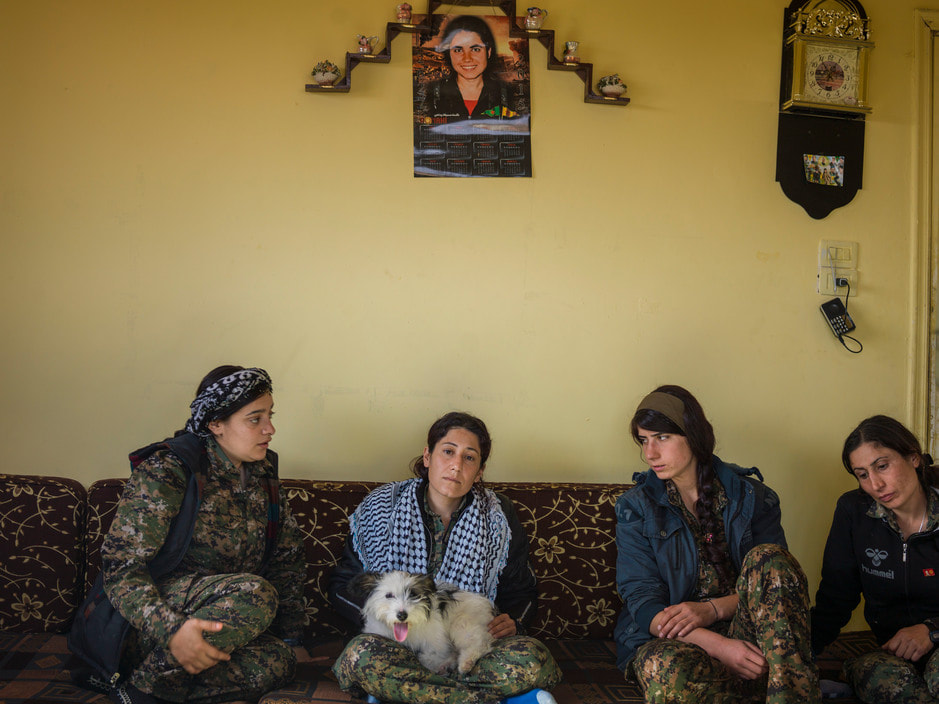
YPJ fighters at their base in Serikani. They came back from the front-line to rest for a few days and regain their energy for the battlefield.
The dog belongs to their commander, Afshin, who believes that in our world, the masterminds of religion, philosophy, and governments are men who never include much of women in their ideologies. Afshin says that YPJ is here to change this inequality between men and women. Serikani, Rojava, Syria, 2015. © Newsha Tavakolian / Magnum Photos
|
|
Delve deeper |

